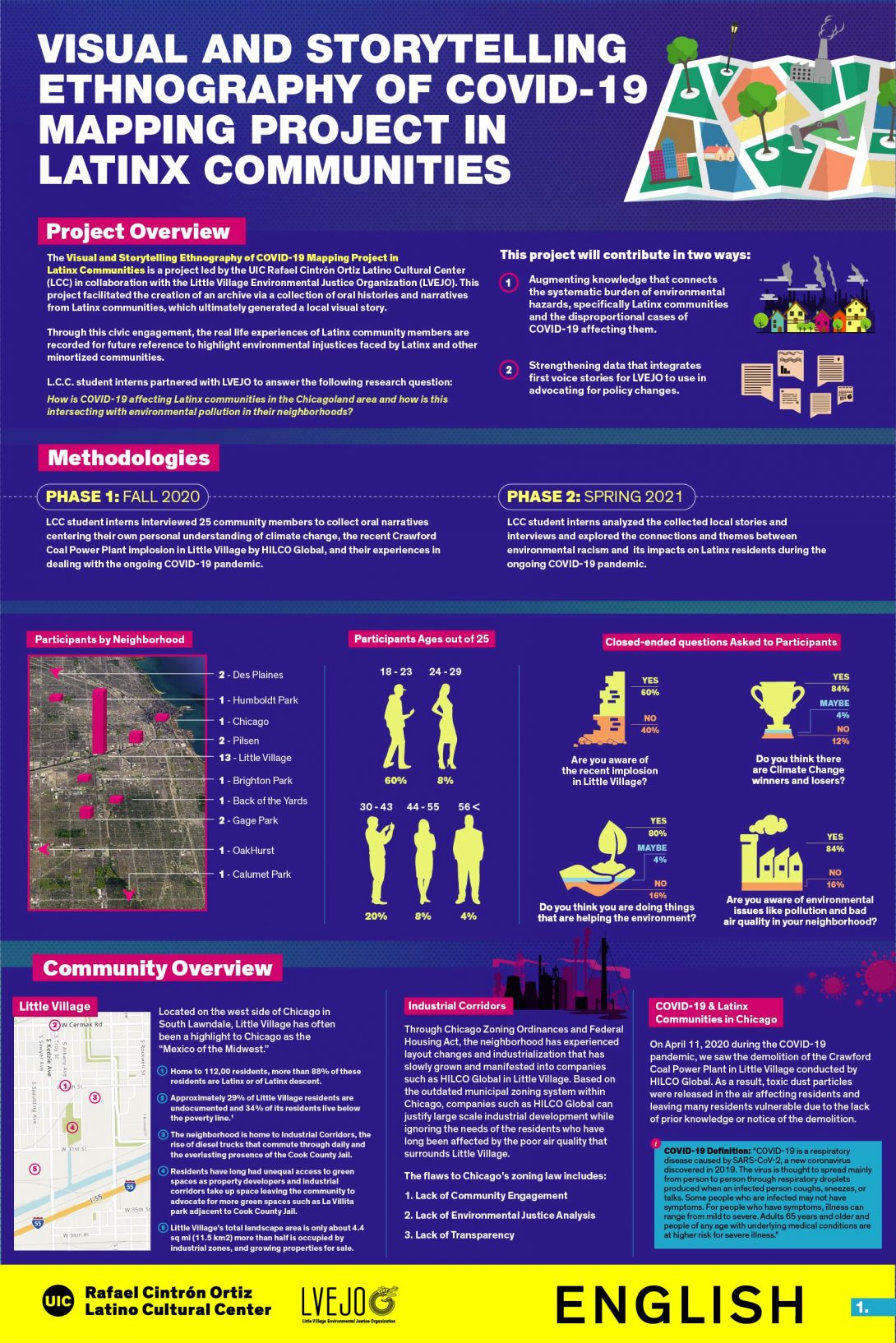Visual and Storytelling Ethnography of COVID-19 Mapping Project in Latinx Communities
infographic

Project Overview
The Visual and Storytelling Ethnography of COVID-19 Mapping Project in Latinx Communities is a project led by the UIC Rafael Cintrón Ortiz Latino Cultural Center (LCC) in collaboration with the Little Village Environmental Justice Organization (LVEJO). This project facilitated the creation of an archive via a collection of oral histories and narratives from Latinx communities, which ultimately generated a local visual story.
Through this civic engagement, the real life experiences of Latinx community members are recorded for future reference to highlight environmental injustices faced by Latinx and other minoritized communities.
L.C.C. student interns partnered with LVEJO to answer the following research question: How is COVID-19 affecting Latinx communities in the Chicagoland area and how is this intersecting with environmental pollution in their neighborhoods?
This project will contribute in two ways:
1). Augmenting knowledge that connects the systematic burden of environmental hazards, specifically Latinx communities and the disproportional cases of COVID-19 affecting them.
2). Strengthening data that integrates first voice stories for LVEJO to use in advocating for policy changes.
Methodologies
Phase 1: Fall 2020
LCC student interns interviewed 25 community members to collect oral narratives centering their own personal understanding of climate change, the recent Crawford Coal Power Plant implosion in Little Village by HILCO Global, and their experiences in dealing with the ongoing COVID-19 pandemic.
Phase 2: Spring 2021
LCC student interns analyzed the collected local stories and interviews and explored the connections and themes between environmental racism and its impacts on Latinx residents during the ongoing COVID-19 pandemic.
Participants by Neighborhood
Little Village – 13; Pilsen – 2; Gage Park – 2; Des Plains – 2; Humboldt Park – 1; Chicago – 1; Brighton Park – 1; Back of the Yards – 1; Oakhurst – 1; Calumet Park -1
Participants Ages out of 25
18 – 23: 60%; 24 – 29: 8%; 30 – 43: 20%; 44 – 55: 8%; 56 < 4%
Closed-ended questions Asked to Participants
Are you aware of the recent implosion in Little Village? Yes: 40%, No: 40%
Do you think there are Climate Change winners and losers? Yes: 84%, Maybe: 4%; No: 12%
Do you think you are doing things that are helping the environment? Yes: 80%, Maybe: 4%; No: 16%
Are you aware of environmental issues like pollution and bad air quality in your neighborhood? Yes: 84%, No: 16%
Community Overview
Little Village
Located on the west side of Chicago in South Lawndale, Little Village has often been a highlight to Chicago as the “Mexico of the Midwest.”
Home to 112,00 residents, more than 88% of these residents are Latinx or of Latinx descent.
Approximately 29% of Little Village residents are undocumented and 34% of its residents live below the poverty line.
The neighborhood is home to Industrial Corridors, the rise of diesel trucks that commute through daily and the everlasting presence of the Cook County Jail.
Residents have long had unequal access to green spaces as property developers and industrial corridors take up space leaving the community to advocate for more green spaces such as La Villita park adjacent to Cook County Jail.
Little Village’s total landscape area is only about 4.4 sq mi (11.5 km2) more than half is occupied by industrial zones, and growing properties for sale.
Industrial Corridors
Through Chicago Zoning Ordinances and Federal Housing Act, the neighborhood has experienced layout changes and industrialization that has slowly grown and manifested into companies such as HILCO Global in Little Village. Based on the outdated municipal zoning system within Chicago, companies such as HILCO Global can justify large scale industrial development while ignoring the needs of the residents who have long been affected by the poor air quality that surrounds Little Village.
The flaws to Chicago’s zoning law includes:
1. Lack of Community Engagement
2. Lack of Environmental Justice Analysis
3. Lack of Transparency
COVID-19 & Latinx Communities in Chicago
On April 11, 2020 during the COVID-19 pandemic, we saw the demolition of the Crawford Coal Power Plant in Little Village conducted by HILCO Global. As a result, toxic dust particles were released in the air affecting residents and leaving many residents vulnerable due to the lack of prior knowledge or notice of the demolition.
COVID-19 Definition: “COVID-19 is a respiratory disease caused by SARS-CoV-2, a new coronavirus discovered in 2019. The virus is thought to spread mainly from person to person through respiratory droplets produced when an infected person coughs, sneezes, or talks. Some people who are infected may not have symptoms. For people who have symptoms, illness can range from mild to severe. Adults 65 years and older and people of any age with underlying medical conditions are at higher risk for severe illness.”